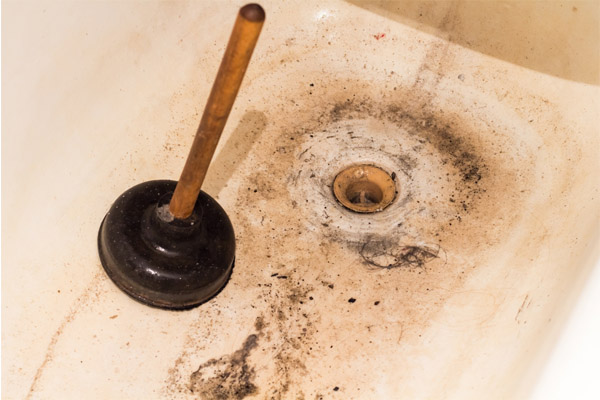My Guide to Effluent Emergence in the Bathtub
My Guide to Effluent Emergence in the Bathtub
Blog Article
The article underneath relating to What to Do if Sewage Starts Coming Up Through Your Bathtub is without a doubt informative. You should investigate for yourself.

Sewer backup in the tub can be a traumatic and unhygienic issue for any type of home owner. Not just is it bothersome, but it likewise poses serious wellness dangers and shows underlying problems with the plumbing system. Recognizing why sewer is turning up with the bath tub is vital for taking appropriate action to attend to the problem successfully.
Introduction to the Problem
Usual Reasons for Sewage Back-up
Obstructions in the Sewer Line
Among one of the most typical reasons for sewage back-up is an obstruction in the sewer line. This can take place because of the accumulation of particles, oil, or international items in the pipes, stopping correct circulation and triggering sewage to back up into your bath tub.
Tree Origin Breach
Tree roots seeking moisture and nutrients can infiltrate sewage system lines with tiny fractures or joints. With time, these roots can grow and increase, causing significant damages to the pipes and leading to sewer backup concerns.
Recognizing the Problem
When sewage draws back up into the bathtub, it's a clear indicator of an issue with the drainage system. The wastewater that ought to be streaming away from your home is instead discovering its back right into your home, which can lead to substantial damage and health hazards.
Potential Reasons
A number of elements can contribute to sewage back-up in the tub. From clogs in the sewage system line to problems with the plumbing infrastructure, recognizing the origin is crucial for finding a service.
Aging Infrastructure
Older homes might have outdated plumbing systems that are more vulnerable to corrosion, cracks, and damage. As pipelines age, they become much more susceptible to leakages and clogs, enhancing the likelihood of sewage back-up occurrences.
Heavy Rainfall or Flooding
Throughout periods of heavy rainfall or flooding, the drain system may become overloaded with excess water, creating backups and overflows. This can lead to sewage backing up right into tubs and other fixtures inside the home.
Indicators of Sewer Backup
Foul Odors
Unpleasant smells rising from drains or fixtures, specifically in the shower room, might suggest sewage back-up issues. These smells are frequently strong and persistent, signifying a problem that requires prompt focus.
Slow Draining Fixtures
Bathtubs, sinks, and bathrooms that drain gradually or not whatsoever could be experiencing sewage backup. If multiple fixtures are affected simultaneously, it's most likely that the problem originates from an usual point, such as the main sewer line.
Gurgling Noises
Strange gurgling or bubbling noises coming from drains when water is running elsewhere in your house are a sign of air trapped in the plumbing system. This air buildup can arise from sewage back-up and need to be investigated immediately.
Health Risks Related To Sewage Backup
Contamination of Water Supply
Sewage backup can pollute the water in your home, posturing a major health danger to you and your family members. Exposure to polluted water can lead to gastrointestinal problems, skin infections, and other diseases.
Mold and mildew Growth
Moisture from sewer backup can develop optimal conditions for mold and mildew growth in your home. Mold spores can exacerbate respiratory issues and trigger allergic reactions in sensitive people, making punctual cleaning necessary.
Spread of Condition
Sewer includes damaging bacteria, viruses, and parasites that can trigger a series of illness, consisting of hepatitis, cholera, and gastroenteritis. Entering into contact with sewer or infected surface areas puts you at risk of infection.
Cleaning Up After Sewage Back-up
Disinfection Procedures
Thoroughly disinfect and sanitize influenced locations after sewer backup to eliminate hazardous germs and stop mold and mildew development. Use proper cleansing products and protective equipment to make sure safe and effective clean-up.
Reconstruction of Impacted Areas
Fix any type of damages to floor covering, walls, or fixtures triggered by sewage back-up. Depending on the extent of the damage, you might require to replace carpets, drywall, or various other materials to recover your home to its pre-loss condition.
Immediate Actions to Take
Turning Off Supply Of Water
In case of sewer back-up, it's vital to turn off the supply of water to avoid more contamination and damage. Find the main water shutoff valve in your house and shut it off till the concern can be dealt with.
Calling a Professional Plumber
Taking care of sewage backup is not a do it yourself task. Get in touch with a qualified plumber with experience in managing sewage-related problems to assess the scenario and execute needed repair services or cleanings.
Preventing Contact with Polluted Water
Up until the sewage back-up is solved, avoid contact with infected water to avoid the spread of microorganisms and pathogens. Use safety equipment if you need to remain in the damaged area and wash your hands thoroughly later.
Preventive Measures
Routine Upkeep of Sewer Lines
Schedule regular inspections and maintenance of your sewer lines to recognize and deal with possible problems prior to they escalate right into significant issues. This can include cleaning debris, examining for tree origin breach, and repairing any type of broken pipes.
Mounting Bayou Shutoffs
Consider setting up bayou shutoffs in your plumbing system to avoid sewage from flowing back right into your home throughout durations of heavy rainfall or flooding. These shutoffs immediately close when water starts backing up, safeguarding your property from contamination.
Correct Disposal of Home Waste
Stay clear of flushing anything aside from toilet paper and human waste down the bathroom to prevent blockages and clogs in the drain line. Dispose of oil, oil, and other household chemicals appropriately to decrease the danger of plumbing problems.
Why Is Water Backing Up in My Bathtub When I Flush My Toilet?
What to do about a sewer line clog
First, don’t bother with plunging. No amount of plunging will dislodge the clog in a sewer line. The clog is too far away. Plungers are for clogs in the toilet itself, not the sewer line. Plus, the most likely causes of a sewer clog are:
Tree roots Flushed toys or feminine products Grease buildup Those items don’t move easily. And in the case of tree roots, the roots need to be cut out of the pipe and the pipe will need to be repaired.
You’ll need a closet auger. A closet auger is a type of plumber’s snake with a protective cover to keep from scratching the delicate porcelain toilet. If the clog is further down, you may need to remove the toilet or use one of your cleanouts to get to the clog.
We also recommend doing a video inspection of the drain to ensure that the cause of the clog has been completely removed. Otherwise, you could have the same problem again in a few days or weeks.
https://mspplumbingheatingair.com/blog/why-is-water-backing-up-in-my-bathtub-when-i-flush-my-toilet

We hope you enjoyed our piece about What to Do if Sewage Starts Coming Up Through Your Bathtub. Thanks so much for taking the time to read through our article post. Do you know about anybody else who is excited about the niche? Do not hesitate to promote it. Thanks a lot for going through it.
Schedule And Pricing
Report this page